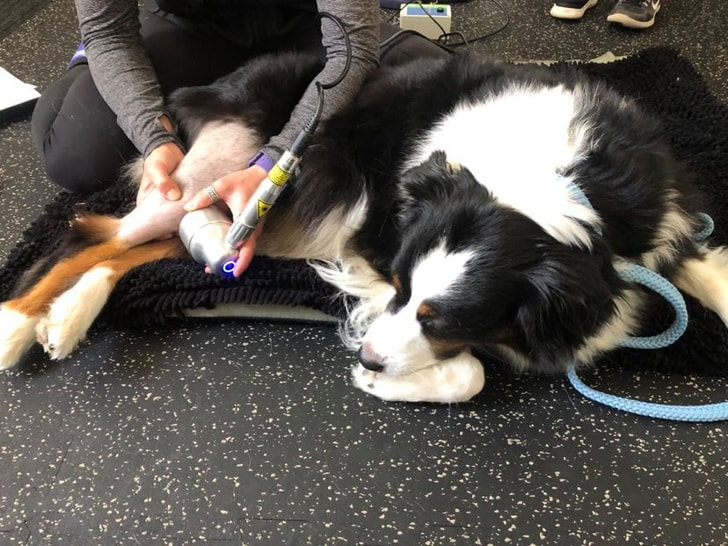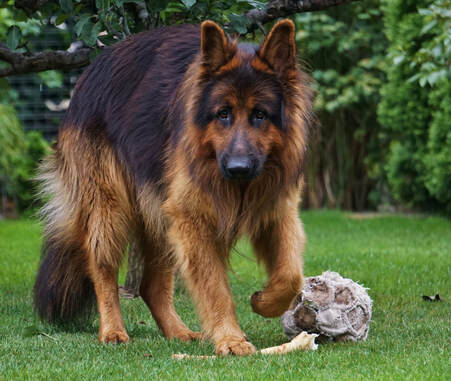|
Have you ever been out enjoying the day with your dog, maybe on a trail or at a show, only for them to suddenly start limping? It can be a gut wrenching moment when your normally happy and free moving friend is suddenly showing signs of pain or discomfort. A limp or gait issue is a common visual clue that something is wrong with our dogs but unfortunately our dog's can't communicate with us directly to tell us what's wrong. The challenge with a limp is that it can indicate a simple issue that may go away with time or some easy care or a limp can indicate something much more complex! Which means we as their trainer partners sometimes have to put the puzzle pieces together to get a clear idea of what's going on. In this week's blog, I'll cover some of the common reasons why your dog may be limping and what we can do in our conditioning programs to reduce the likelihood of a future limp or gait problem. Signs and symptoms associated with lameness include ...
When our dogs have a limp that lasts longer than a few minutes it's time to seek the help of a vet, physical therapist, or chiropractor to determine why your dog is limping. The degree of limping is not always the best indicator for the severity of the issue. For example, cranial caudal ligament (CCL) injuries may show little lameness but could require surgery to repair. Whenever you take your dog to see a health practitioner for an issue its helpful to come with some basic information, such as, how long the lameness has occurred, whether it was a gradual or sudden onset, and what type of activities or movements seem to aggravate the limp. Try to keep a regular health journal and document an issues that arise. Having this history will greatly help your health practitioner get a full picture of the issue. . Understanding the different types of lamenessThere are different types of lameness that can occur and knowing whether your dealing with a gradual, sudden, or intermittent limp is an important aspect in discovering an underlying cause. A gradual onset limp can happen slowly over time – perhaps you’ve been seeing only an occasional limp that has slowly become more common. Gradual onset limps are often caused by an underlying, chronic or degenerative condition such as arthritis or muscle tightness. A sudden onset limp can occur quickly, often the result of an injury or trauma. Have you ever had you dog whip around the yard only to come up lame? It's possible that this is a sudden onset injury. Generally speaking, sudden onset is almost always the result of a high strain activity like running or an impact injury. Intermittent Lameness - “My dog’s limp disappears when I take them for a walk,” is a common thing I hear from my clients. Sometimes a dog who starts the day off with some lameness may seem to get better after moving around for a bit. Have you ever woken up in the morning and felt a little stiff but after walking around for a bit you’ve noticed that stiffness disappears? That’s because movement increases the synovial fluid in the joints which basically acts like an oil that helps the joints move smoothly. Movement also warms up the muscles and flushes out any inflammation. You may see the limp return during a walk as muscles start to fatigue and can no longer work optimally. Why might my dog be lame?Lameness can occur as a result of muscle tightness and imbalance or because of a pathological change to the tissue. Our dog's posture and the way they move can help us determine what the underlying cause of their lameness may be. Limping because of muscle tightness and imbalance
Common causes of limping
What we can do NOW to help reduce the risk of lamenessThere are a number of things we can do to help our dog who is limping - the first step is to determine why they're limping in the first place! If you see your dog limping it's important to not wait and get them evaluated by a health practitioner quickly - this will reduce further compensation issues down the road! Remember, without an understanding of the underlying cause we can't effectively treat the issue. Once we know the cause of the limp we can start to plan a treatment. There are a couple of proactive measures we can take now, however, to reduce the likelihood of our dog's getting an injury resulting in lameness.
While limping is often an early sign to an underlying issue it's still important that we take the appearance of lameness seriously and work quickly to address the underlying cause. Remember that the more information you can provide to your health practitioner the easier and quicker they'll be able to determine what's wrong and get you and your dog back on the road to recovery! A conditioning program is a great way to prevent future injury and can better prepare our dogs for recovery in the event of lameness. If your dog has recently shown signs of a limp I'm more than happy to discuss a game plan to help them move and feel better!
2 Comments
1/11/2021 06:14:09 am
Carolyn, My dog is a nine (9) year old lab Male who is a field trial competitor and has developed a noticeable limp to his left front leg after exercise. I have had "Cold Laser Treatments" performed to both shoulders and elbows and wrists with no noticeable improvements. My vet could not find any definitive diagnosis and recommended possibly having acupuncture or chiropractic adjustment performed.
Reply
11/15/2022 08:37:42 am
Thank you for explaining some of the most common reasons for limping. My dog started limping after taking him on his walk this morning. I'll be calling our vet soon to see if we can help him with recovering soon.
Reply
Leave a Reply. |
AuthorCarolyn McIntyre Archives
March 2024
Categories
All
|



 RSS Feed
RSS Feed